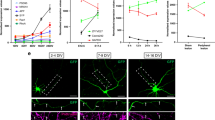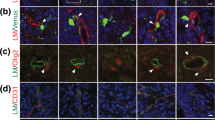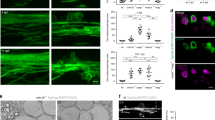Abstract
The decisive role played by adhesive interactions between neuronal processes and the culture substrate in determining the form and extent of neurite outgrowth in vitro1,2 has greatly influenced ideas about the mechanisms of axonal growth and guidance in the vertebrate nervous system. These studies have also helped to identify adhesive molecules that might be involved in guiding axonal growth in vivo. One candidate molecule is laminin, a major gly-coprotein of basal laminae3 which has been shown to induce a wide variety of embryonic neurones to extend neurites in culture4–8. Moreover, laminin is found in large amounts in injured nerves that can successfully regenerate but is absent from nerves where regeneration fails9–11. However, it is unclear to what extent the mechanisms that regulate axonal regeneration also operate in the embryo when axon outgrowth is initiated. Here we have examined the substrate requirements for neurite outgrowth in vitro by chick embryo retinal ganglion cells, the only cells in the retina to send axons to the brain. We show that while retinal ganglion cells from embryonic day 6 (E6) chicks extend profuse neurites on laminin, those from Ell do not, although they retain the ability to extend neurites on astrocytes via a laminin-independent mechanism. This represents the first evidence that central nervous system neurones may undergo a change in their substrate requirements for neurite outgrowth as they mature.
This is a preview of subscription content, access via your institution
Access options
Subscribe to this journal
Receive 51 print issues and online access
$199.00 per year
only $3.90 per issue
Buy this article
- Purchase on Springer Link
- Instant access to full article PDF
Prices may be subject to local taxes which are calculated during checkout
Similar content being viewed by others
References
Bray, D. Nature 244, 93–96 (1973).
Letourneau, P. C. Devl Biol. 44, 92–101 (1975).
Timpl, R. H. et al. J. biol. Chem. 254, 9933–9937 (1979).
Baron von Evercooren et al. J. Neurosci. Res. 8, 179–193 (1982).
Manthorpe, M. et al. J. Cell Biol. 97, 1882–1890 (1983).
Rogers, S. L. et al. Devl Biol. 98, 212–220 (1983).
Smallheiser, N. R., Crain, S. M. & Reid, L. M. Devl Brain Res. 12, 136–140 (1984).
Calof, A. L. & Reichardt, L. F. Devl Biol. 106, 194–210 (1984).
Bignami, A., Chi, N. H. & Dahl, D. Expl Neurol. 85, 226–236 (1984).
Hopkins, J. M., Ford-Holevinski, T. S., McCoy, J. P. & Agranoff, B. W. J. Neurosci. 5, 3030–3038 (1985).
Liesi, P. EMBO J. 4, 2505–2511 (1985).
Kahn, A. J. Brain Res. 63, 285–290 (1973).
Rager, G. H. Adv. Anat. Embryol. Cell Biol. 63, 1–92 (1980).
Sinclair, C. M., Bartlett, P.F., Grieg, D. I. & Jeffrey, P. L. Brain Res. (in the press).
Rostas, J. A. P., Shernan, A., Sinclair, C. M. & Jeffrey, P. L. Biochem. J. 213, 143–152 (1983).
Beale, R. & Osborne, N. N. Neurochem. Int. 4, 587–595 (1982).
Barnstable, C. J. & Drager, H. C. Neuroscience 11, 847–855 (1984).
Perry, V. H., Morris, R. J. & Raisman, G. J. Neurocytol. 13, 809–824 (1984).
Raff, M. C. et al. J. Neurosci. 3, 1289–1300 (1983).
Lander, A. D., Fujii, D. K. & Reichardt, L. F. Proc. natn. Acad. Sci. U.S.A. 82, 2183–2187 (1985).
Davis, G. E., Manthorpe, M., Engvall, E. & Varon, S. J. Neurosci. 5, 2662–2671 (1985).
Leifer, D., Lipton, S. A., Barnstable, C. J. & Masland, R. H. Science 224, 303–306 (1984).
McCaffery, C. A., Raju, T. R. & Bennett, M. R. Devl Biol. 104, 441–448 (1984).
So, K.-F. & Aquayo, A. J. Brain Res. 32, 349–354 (1985).
Noble, M., Fok-Seang, J. & Cohen, J. J. Neurosci. 4, 1892–1903 (1984).
Fallen, J. S. J. Cell Biol. 100, 198–207 (1985).
Silver, J. & Sapiro, J. J. comp. Neural. 202, 521–538 (1981).
Kryanek, S. & Goldberg, S. Devl Biol. 84, 41–50 (1981).
Greve, J. M. & Gottlieb, D. L. J. cell. Biochem. 18, 221–230 (1982).
Horwitz, A. et al. J. Cell Biol. 101, 2134–2144 (1985).
Liesi, P., Dahl, D. & Vaheri, A. J. Cell Biol. 96, 920–924 (1983).
Grummet, M., Hoffman, S. & Edelman, G. M. Proc. natn. Acad. Sci. U.S.A. 81, 267–271 (1984).
Keilhauser, G., Faissner, A. & Schachner, M. Nature 316, 728–730 (1985).
Adler, R., Jordan, J. & Hewitt, A. T. Devl Biol. 112, 100–114 (1985).
Cohen, J. Neurosci. Lett. Suppl. 22, 36 (1985).
McLean, I. W. & Nakane, P. K. J. Histochem. Cytochem. 22, 1077–1083 (1984).
Johnson, G. D. et al. J. immun. Meth. 55, 231–242 (1982).
Lemmon, V. Devl Brain Res. 23, 111–120 (1985).
Bottenstein, J. & Sato, G. H. Proc. natn. Acad. Sci. U.S.A. 76, 515–517 (1979).
Author information
Authors and Affiliations
Rights and permissions
About this article
Cite this article
Cohen, J., Burne, J., Winter, J. et al. Retinal ganglion cells lose response to laminin with maturation. Nature 322, 465–467 (1986). https://doi.org/10.1038/322465a0
Received:
Accepted:
Issue Date:
DOI: https://doi.org/10.1038/322465a0
This article is cited by
-
The impact of genetic manipulation of laminin and integrins at the blood–brain barrier
Fluids and Barriers of the CNS (2022)
-
Three-Dimensional Retinal Organoids Facilitate the Investigation of Retinal Ganglion Cell Development, Organization and Neurite Outgrowth from Human Pluripotent Stem Cells
Scientific Reports (2018)
-
Traumatology of the optic nerve and contribution of crystallins to axonal regeneration
Cell and Tissue Research (2012)
-
Molecular mechanisms of optic axon guidance
Naturwissenschaften (2005)
-
Growth-cone attraction to netrin-1 is converted to repulsion by laminin-1
Nature (1999)
Comments
By submitting a comment you agree to abide by our Terms and Community Guidelines. If you find something abusive or that does not comply with our terms or guidelines please flag it as inappropriate.



